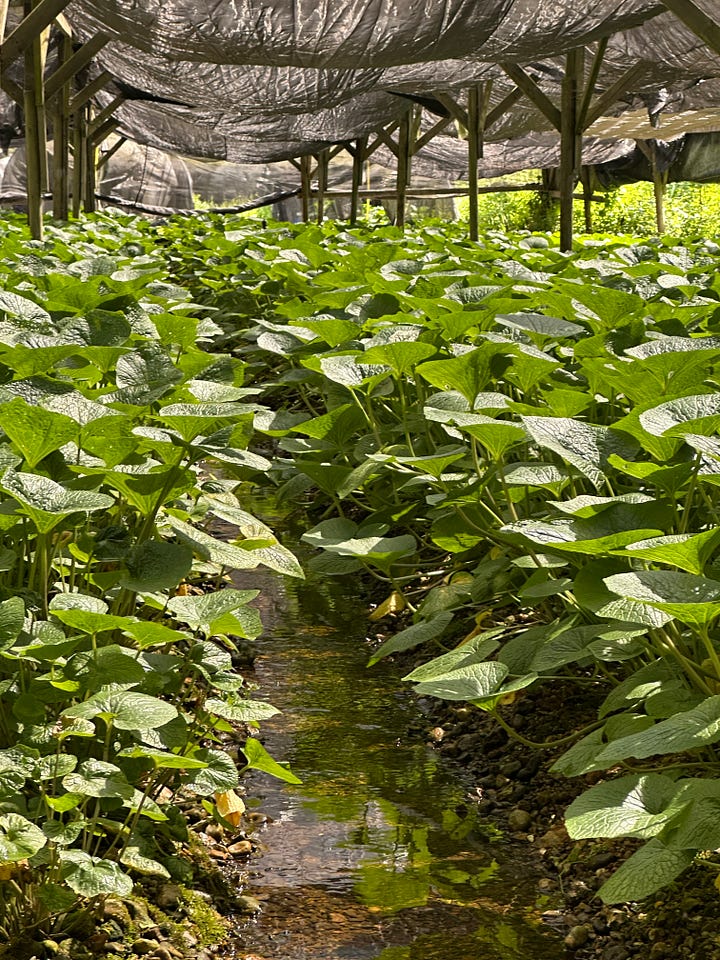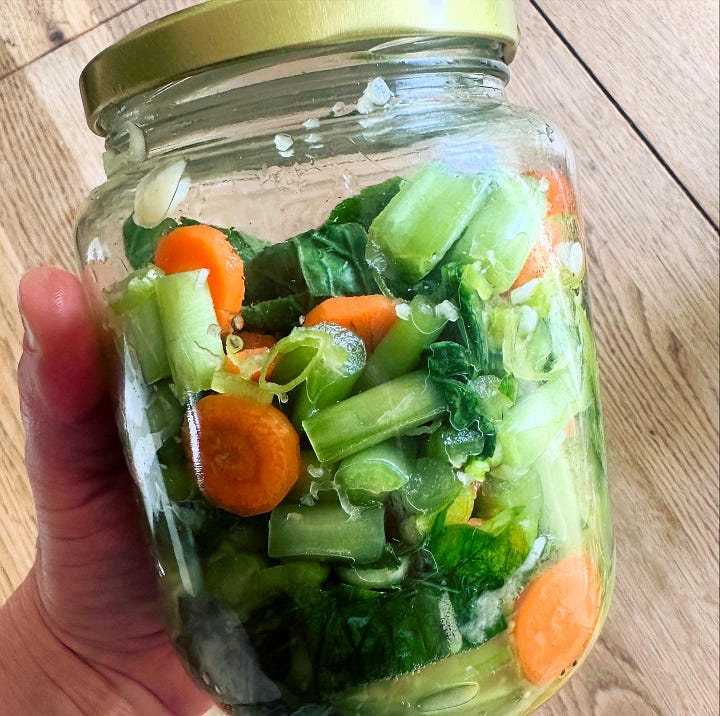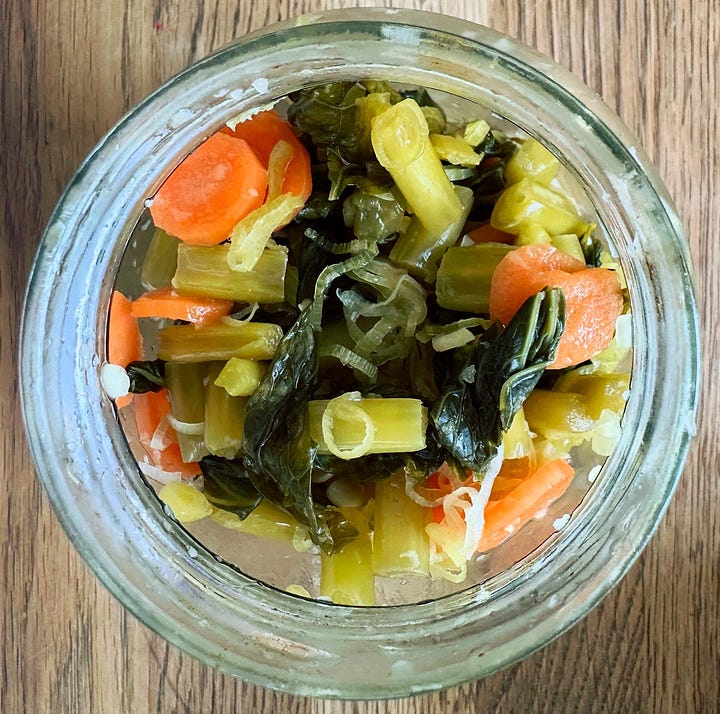In Good Taste #: 92 Wasabi leaf kimchi
A chilli-free kimchi that still has a kick; wasabi in "not actually horseradish" shock; 2 Willow Road and Mission Impossible
Well, hello there! How are you?
Good I hope.
(Not up for the chitchat? Completely get it. Click the email title to go to a web-based version then jump straight to the recipe or Cultural Fun.)
I mentioned last week that I had been lucky enough to visit The Wasabi Company’s farm near Micheldever in Hampshire.
This week I wanted to tell you a bit more about it and share a recipe I made with the leaves and stems of the rhizome I was given to bring home.
Before we toured the beds, Jon Old gave us a super-interesting little introduction to wasabi. The first record of the word is from 7th century Japan although there’s archeological evidence that it was being foraged and eaten as long ago as 14,000 BC. Its natural habitat is fast-flowing mountain streams and it was highly valued for its medicinal and flavour-giving properties. So much so that a a 10th century law book states that it is allowable to pay taxes in wasabi!


The plants weren’t cultivated (as opposed to foraged) until the 16th century when villagers from Utogi were able to get some gathered in the mountains to take root in their village stream. Their local Shogun, Tokugawa Ieyasu (the chap on whom the recent hit show was based) forbade its sale outside the area under his control but eventually cultivation spread.
It’s been used as a seasoning for sushi since the early 18th century. I remember in the 90s - when sushi was becoming mainstream in the UK - having wasabi explained to me as “Japanese horseradish”. Which totally makes sense as they both have that ticklish nasal heat. But it isn’t actually related to horseradish! Wasabi is actually a brassica - a cousin of cabbage, broccoli etc. Therefore it’s not botanically correct to call the edible stem a rhizome but that’s what it’s known as anyway, even in the industry.
Watercress, the Old family’s original crop, is also a brassica which thrives in similar conditions to wasabi. They repurposed some disused watercress beds in 2010 to become Europe’s first commercial growers.
The distinctive taste is an evolutionary defence against predators. Jon explained that wasabi’s heat comes from a compound called isothiocyanates which are very volatile. So, unlike chilli heat (from capsaicin) it gets up your nose rather than remaining in the mouth. The flavour is created when the cell walls are ruptured: it peaks three to five minutes after grating and then dissipates over half an hour or so. Click through to Instagram to watch a short video of Jon talking about the chemistry involved.
Sampling the real stuff was a revelation. Totally different to the blobs you get next to cheap sushi which isn’t usually expensive, volatile wasabi, but a combination of horseradish, mustard, sugar and green food colouring.
Although it’s the rhizomes that are most highly prized, there’s plenty of flavour in the leaves and stems too. When I was given mine as a big, beautiful bouquet, I knew I was going to try fermenting them into a kimchi.


Thanks so much to Jon and everyone at The Wasabi Company for an informative and inspiring day out, to the Guild of Food Writers for organising it. Especially to Julie for returning my abandoned notebook!
I have other wasabi experiments underway which I’ll be sharing if successful. Subscribe to know what happens…
Small pre-recipe break just to tell you about an upcoming event which might be of interest to London-based folk. Not one of mine, but something organised by my friends at Growing Communities which sounds really nice.
On Sunday 8th June they have a trip to Hook & Sons organic dairy farm in Sussex. There’s a coach leaving from Stoke Newington at 9am. Click the link for more info and tickets. Sadly I can’t go as we have a houseguest that weekend but I thought it might be right up some of your streets.
Recipe: Wasabi leaf kimchi
OK, here we go. This turned out so beautifully. Fiery but clean-tasting. I didn’t add any chilli as I wanted the heat to come from the wasabi itself - an addictive short-lived heat, its pungency dying away so you go back for another bite. The carrot adds a little contrasting sweetness that works really well. I ate this alongside some salmon and rice, drizzled with a little sesame oil and sprinkled with toasted seeds. But it would go anywhere you want a bit of non-chilli bite.
I used some sudachi kombu ponzu I was gifted at the farm, a combination of soy sauce, citrus juice, seaweed stock and mirin but see notes for alternatives.
Makes approximately one 750ml jar
Ingredients
1 large bunch wasabi stems and leaves (approximately 500g), washed
2 carrots
4 spring onions
4 cloves garlic
2 inches fresh ginger root
2 tablespoons sudachi kombu ponzu
1 tablespoon sugar
Method
Brine the wasabi and other veg. Chop the wasabi stems into 1cm lengths. Stack the leaves and roll into a cigar shape before slicing into 1cm ribbons. Put the pieces in a large bowl. Peel and thinly slice the carrot. Finely slice the spring onion. Add both to the wasabi, along with 25g salt and enough water to cover. Leave for an hour or so until the leaves are wilted.
Make the paste. Finely chop, grate or crush the garlic and ginger to a paste. Put it in a small bowl. Add the ponzu and sugar and mix well. Set aside.
Wash and drain the wasabi and veg. Get rid of as much water as possible. A salad spinner is useful. It should still taste salty but not overwhelmingly so.
Massage the paste over the veg. Make sure each piece is evenly coated.
Pack into a jar. Try and eliminate as many air pockets as possible. Weigh it down with a pickle weight, half an onion or a sandwich bag full of brine.
Leave at room temperature for three days, regularly “burping” and tasting then store in the fridge. This was delicious after three days and keeps getting better.


On making and after a week.
Notes (If Ifs And Ands Were Pots And Pans…)
If you weren’t lucky enough to harvest your own wasabi rhizome with leaves intact, The Wasabi Company sells them. And also plants. Although that’s a very long-term, “first catch your hare” way into this recipe… If you only manage to get hold of a few leaves you could bulk them up with cabbage, Napa or otherwise.
TWC sell all sorts of other delicious stuff too, including the ponzu sauce mentioned above. You can substitute it for 1 tablespoon of soy sauce and 1 of lime juice.
If you somehow have loads and loads of wasabi leaves to use up and want other ideas then they are also good finely shredded in a salad. Or I got the train home with Erin Niimi Longhurst who said her grandma used to tempura them which sounds incredible. I can’t wait for my tiny little plants to get big enough to harvest some more.
Cultural Fun
James and I visited 2 Willow Road, the former Hampstead home of Modernist architect Erno Goldfinger. I’d wanted to go for years but entry is only by pre-booked ticket and was never on the site at the right time before.
The house itself is stunning, full of clean lines and light and art. You’re not alowed to take photos inside as much of the art is still under copyright but you can get an idea from their Instagram:
The only pick I took was this sneaky snap of the “historic toilet” which made me laugh.
However. Hmm. I’m not sure how to say this without being mean. The elderly volunteer tour guide clearly knew his stuff but sadly lacked the skills to deliver it in an engaging way. I’d hoped for background on Goldfinger and the context of the house - what is Modernism? etc. - but we didn’t really get any of that. Just a slow shuffle from room to room. Ah well. I bought a guide books so can educate myself…
In a very different cultural vein we also went to see Mission Impossible: The Final Reckoning which we loved. We treated ourselves to the BFI Imax and had popcorn and everything. There was maybe a little bit too much exposition in the first half but the second half was thrilling.
With an AI baddy, the whole thing was an argument for human craft over computer soullessness. It’s an argument Tom Cruise makes eloquently every time he insists on doing his own stunts (he’s 62!). The analogue vs digital message was rammed home by the most spectacular of said stunts taking place on a pair of primary-coloured biplanes. Certainly the most fun contribution to the artificial intelligence debate…
Bye! See you next week!
In the meantime, if you felt like sharing In Good Taste with friends or family who might enjoy it, you can do so with the button below.
Or upgrade to paid to support the work I do. Either would mean a lot to me. Thanks so much.
In Good Taste is a Sycamore Smyth newsletter by me, Clare Heal.
It’s free to subscribe and new issues will appear in your inbox every Thursday.
You can also access it via the Substack website or app where each issue remains free or a month after publication but older posts and archive access are for paid subscribers only. If you can afford it, do consider upgrading to paid to support my work - those vegetables won’t ferment themselves...
I also occasionally include affiliate links to Bookshop.org and will earn a small commission on anything purchased via a clickthrough.
You can also find me on Instagram or visit my website to find information about my catering work, cookery lessons and upcoming events.











LOVE fresh wasabi - one of my favourite holidays ever was extending a work trip to Japan to travel around Honshu by train for two weeks. It coincided with my birthday, which I spent visiting Daio wasabi farm outside Matsumoto.
Wasabi icecream is also unexpectedly yum!